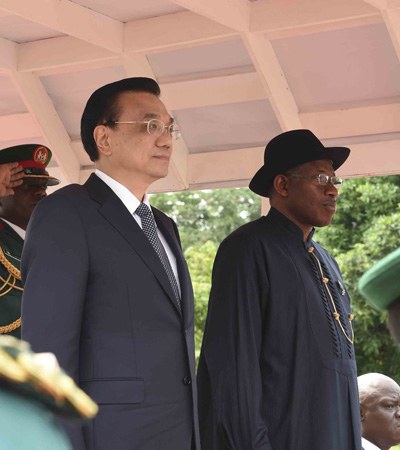|
 |
|
PREMIER WELCOMED: Chinese Premier Li Keqiang and Nigerian President Goodluck Jonathan participate at the welcoming ceremony in Abuja, Nigeria, on May 7 (LI XUEREN) |
Referring to six areas of bilateral cooperation, he stressed, "Both China and Africa are at their respective crossroads of development in the new era. The six areas not only are of African countries' general concern of participating in economic globalization based on independence, but also reflect China's practical interests of accelerating its economic transformation."
He said that the core of the six key areas is cooperation in industry, while cooperation in the remaining five areas is meant to solve problems concerning financing, marketing, environmental protection, personnel and security.
Cooperation in the six areas is China's mid- and long-term strategic plan of boosting China-Africa cooperation.
Yang Lihua, a senior research fellow with the CASS, pointed out that the premier's speech showed the consistency of China's friendship with and its policy concerning Africa in the past 50 years. "During the last five decades, the China-Africa relationship has been bound by mutual respect and reciprocity. Our goal, approach and destination have been consistent in spite of changing circumstances," said Yang.
Based on the similar target of fighting imperialism to gain national independence, the Chinese and African peoples started to support each other in the mid-20th century.
On October 25, 1971, China resumed its legal status in the United Nations with support from the developing world, including many African countries. Late Chinese leader Mao Zedong emphasized, "It's our African brothers that have carried us into the UN."
The China-Africa relationship has entered a new phase since the beginning of the 21st century. In October 2000, the Forum on China-Africa Cooperation was launched. In 2006, China and Africa agreed to upgrade their relationship to a new type of strategic partnership featuring political equality and mutual trust, economic win-win cooperation and cultural exchanges.
Two wheels of cooperation
About 60 cooperation documents were signed during Premier Li's Africa tour, covering fields like economic, cultural, agricultural, health and personnel training cooperation. This great achievement is also closely linked to the six areas that he proposed.
Yang believed that the Chinese premier's proposal is very encouraging. According to the new 4-6-1 mode, China will expand the scope of industrial cooperation by including trade, investment and infrastructure construction, she said. "China is at a crucial stage of industrial restructuring and transformation of its economic growth pattern. This is a good way to closely match China's development with Africa's," said Yang.
Premier Li also laid out the blueprint for increasing China-Africa trade volume to $400 billion by 2020. Yang believed such a goal is relatively conservative. In 2013, China-Africa trade reached $210 billion, 2,000 times that of 1960. China has been Africa's biggest trading partner for the past five years; in addition, more than 2,500 Chinese companies are operating in Africa, creating over 100,000 jobs. According to a report by the International Monetary Fund, China-Africa cooperation has contributed to more than 20 percent of Africa's development.
| 